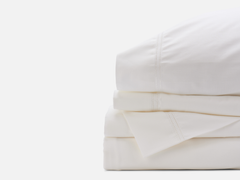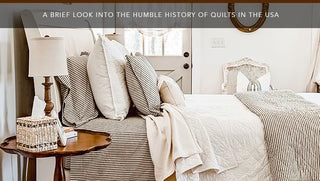Quilts have a long, varied, and fascinating history. People all over the world have been making quilts for centuries—from quilters in Ghana who used patterns with Sankofa symbols all the way to the American Amish who mastered the craft. But how did the US create and use quilts, and how did we disseminate them?
How did the art form rise and wane throughout the ages, and what forms of technology helped to make the art form more accessible to the layperson, who was eager to pick up a new hobby? We’ll learn about all these things in this brief look into the humble origin and history of quilts in the USA.
What Is Quilting?
Quilting is an intensive and lengthy process. Our American-made luxury cotton quilts are stunning and masterfully made, but it’s important to understand that it takes quite a long time to make them. This has been the case throughout the ages. Quilts are a form of bedding with multiple layers of fabric. They are commonly composed of upward of three layers that you can use as filler material. Quilting is the process of creating quilts by joining these layers together.
In the beginning, people strung these layers together manually with a needle and thread. Later inventions made the process much easier, specifically when the longarm quilting system and the sewing machine entered the arena. So, what’s the history of quilting in the United States, and how did quilt-making become popular? We’ll discover it together below.
Quilts in the Colonial US
There are many differences in making quilts and duvets, and during the colonial period, we notice a development in both methods. North America inherited several quilting traditions from across the world, especially places in Italy, France, and England. When it came over on the boat, wealthy people were the ones who often had them made on elaborate hand-painted and block-printed fabrics.
At that time, thread count wasn’t a strong consideration. While we didn’t have the concept of thread count yet, the wealthy naturally inclined themselves toward softer fabrics, which we often conflate with sheet softness. The fascinating palampores were also shipped from India on sailing vessels and distributed among the wealthy. Quilts of this kind were truly a luxury.
However, settler peasants often made coverlets with looms and created bed rugges. Back then, quilts were far thicker, protecting people from inclement weather and extreme climates. In 1634, Richard Loe commanded an emigrant ship called the Ark and set to sail to Maryland. He had a flock quilt, an old sheet, and a rug—all linguistic indicators of a quilt-like blanket in his possession.
Furthermore, we found historical evidence of colonial women recycling fabric scraps for bedding. This could have been the first clue of the traditional “patchwork quilt” many people are familiar with. They layered the sacks with wool batting like we do today and incorporated them with linsey-woolsey backs, where they quilted them in decorative motifs and plumes.
Types of Colonial Quilts
People made many types of quilts during this time. It’s important to examine them to understand the typography of quilting in the colonial era.
Whole Cloth Quilts
Early whole-cloth quilts look like solid, monochromatic pieces of fabric. However, they’re composed of many strips of fabric, traditionally cotton, since looms—which were the pinnacle of quilting technology during colonial periods—couldn’t create widths of cloth that would cover the entire bed. They were the most economical form of bedcovering for many people.
Broderie Perse Quilts
The technique people used to make broderie perse quilts involved taking motifs, cutting printed fabric, and placing them on a solid background. Some quilters still use this method, though it originated in the 18th century when they imported much of this fabric from India. Given that it was an import, like many versions of quilts, it was expensive. Even well-off people had a hard time getting hold of them.
Medallion Quilts
Medallion quilts were print patterns created around a symbol in the middle of the fabric. It often made it appear like a mandala with motifs such as pieced patterns and stars. A solid border of different designs typically surrounds the central area.
The Golden Age of Quilts
In pre-Revolutionary US colonies, France and England were major suppliers of most fabrics, although people often made linens and clothing back home. During the 19th century, the US produced cotton fabric at cheap rates. Back then, you could do this in a ton of prints, which made the entire process far more affordable than it normally was, even though cotton was largely exported.
The 1840s brought a new style of quilting: the friendship quilt, which is layered with floral and other figures that would be familiar today. Florals were typically multiblock, and this remained popular in the 19th century. In this method, the creator of the quilt signed each block as a keepsake. The 1840s also saw the invention of the sewing machine, which became widely available in the 1940s. This dramatically changed the sewing landscape, making quilting much quicker and easier. This created a boom in the quilt market and led newspapers and magazines to run weekly columns with printed designs for quilting enthusiasts.
During the US Civil War, women would raise funds to support the abolitionist movement. They also raised funds for the war effort and gave warmth and comfort to the soldiers in the 1840s. People used quilts as signals to help enslaved people flee to freedom. To do this, people hung quilts in front of safe houses as signals. During the war, there were barriers to making quilts on both sides since cotton grew in the South and was manufactured into fabric in the North.
Quilt Revival in 1960-70
The Amish highlight their quilts in various art displays. They embroider and decorate these for great effect. The Amish greatly influenced and cornered the quilt market. They created bold graphic designs and color combinations and used masterful patterned stitching. Quilts were a huge avenue for creativity since they lived so simply. In Amish homes, it’s common to see sparse furniture with a multi-generation quilt hanging.
In the 1970s, we had a revival of quilt making. Quilts were popular in different patterns and colors, and quilting magazines became all the rage. There were quilting associations and quilting classes. We can largely attribute this to the elusive “American dream.” Many women were housewives in the 1960s, and with so much time on their hands, especially when the children went to school and the chores were complete, you would find them picking up hobbies. Many people saw quilting as a socially permissible activity for women. This led to a boom in TV shows related to quilting and other media to teach the craft. This in-depth look at the history of quilts in the US shows why quilts are still popular today.
The history of quilting in the US is fascinating. Today, we’ve greatly refined our methods, and you can experience that refinement here at Red Land Cotton! Look at our wares today, and enjoy our cotton quilts!









